Where a Michelin star chef goes for paella in Valencia
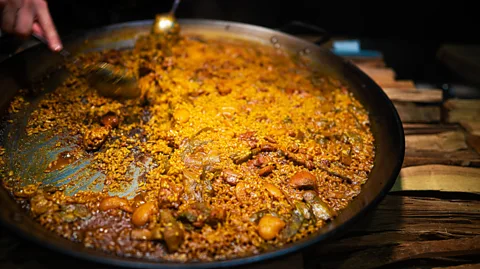 Getty Images
Getty ImagesValencia is the birthplace of paella, and Chef Ricard Camarena knows where to get the real deal. Here are his top picks in his hometown, from Goya Gallery to Napicol.
Outside Spain, paella – a delicious, saffron-hued mélange of rice, vegetables and meat – is unquestionably the nation's most widely recognised dish. But in sunny Valencia, the birthplace of the beloved recipe, controversy abounds as to what paella actually is.
Bordered by the Mediterranean and surrounded by farmlands, the coastal city of Valencia teems with excellent produce. It's in the fertile Albufera, a nature park 10km from the city, where Valencian farmers are believed to have first added rice to whatever humble ingredients were at hand, then cooked them in a single shallow paella (pan), giving the dish its name. For most Valencians today, one true paella Valenciana exists, while other rice dishes are considered "rice with things".
We asked Michelin-starred chef Ricard Camarena, a Valencia Community native whose parents and grandmother taught him to cook paella when he was just a boy, what "real" paella Valenciana is, and where to get it.

The SpeciaList
Ricard Camarena is a Valencian chef who traded in a musical career to devote himself to cooking. He is the owner of five restaurants in Valencia, including the two-Michelin star and Michelin Green Star recipient, Ricard Camarena Restaurant. Committed to sustainability, he considers the Valencian orchard and the Mediterranean Sea his pantry.
"Paella valenciana is a pretty specific recipe," says Camarena. "It should never contain fish; it includes meat and vegetables… The most traditional version includes chicken, rabbit, sometimes snails, flat green beans, garrofó [white] beans, garlic, paprika, saffron and tomato."
No seafood – really? Well, not technically; while paella shouldn't contain fish, it can have other kinds of seafood. Arroz del señoret, a revered and popular Valencian rice dish with peeled seafood like shrimp and mussels is actually what most die-hard Valencians call seafood paella, whereas the rest of Spain calls seafood with rice "paella de marisco". Camarena admits: "I'm not a purist. To me, seafood paella can be called that because it's cooked in a paella."
But Camarena doesn't serve any kind of paella at the five restaurants he helms in Valencia: "Since everyone here has such reverence for paella and we've all had excellent ones, I try to avoid making dishes with traditional references."
Here is where Camarena eats "real" paella Valenciana in Valencia.
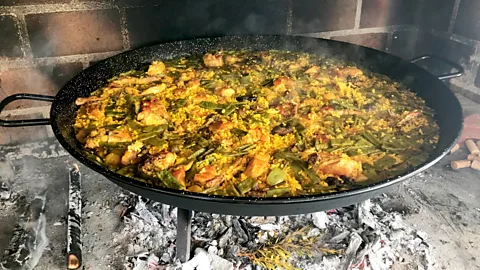 Getty Images
Getty Images1. Best for observing the traditional cooking process: Casa Carmela
Originally a beach shack that served as a changing room for occasional bathers, Casa Carmela has been managed by the same family since it was founded in 1922. Four generations later, this seaside restaurant now has Toni Novo at the helm, who continues to prepare paella Valenciana the way his great-grandmother Carmen once did.
"I would recommend Casa Carmela for a traditional paella Valenciana cooked over a wood fire," says Camarena. The arrocería (a restaurant specialising in paella and other rice dishes) uses orange wood to cook its paellas and has an open kitchen for patrons to watch as several paellas cook simultaneously over the fire. "It's a pretty orthodox paella, sticking to a very traditional and straightforward approach – authentic and much like the kind you’d find in a private home, made with a similar method," says Camarena. "It has that authentic, rustic and robust feel to it."
Averaging about 25 wood-fired paellas per service, the paellas at Casa Carmela are always set in the middle of the table for diners to share and served with a wooden spoon – the traditional way of enjoying the dish.
Website: https://www.casa-carmela.com
Address: C/ d'Isabel de Villena, 155, Poblats Marítims, 46011 València, Valencia
Phone: +34 963 71 00 73
Instagram: @casacarmelarestaurant
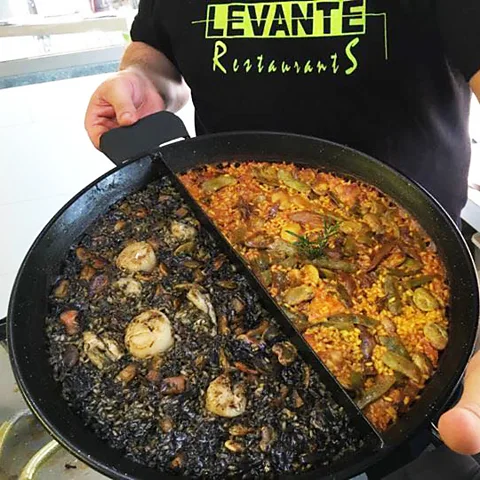 Levante Valencia
Levante Valencia2. Best for learning from a paella master: Levante
Rafael Vidal, Levante's owner and chef, has been offering masterclasses in paella since around 2009 at its first location, which is outside the city. And besides teaching locals and visitors how to make paella, Vidal has had some high-profile students. "Levante has always championed paella as their signature dish," says Camarena. "In fact, he mentored [Spanish celebrity chef] José Andrés and collaborated with him on his paella projects in Las Vegas, assisting him throughout. Levante is definitely a must-visit."
Join in
World Paella Day is celebrated on 20 September.
A second location of Levante opened in 2011 within the city, but moved to a larger location near Valencia's zoo, the Bioparc, in 2019. "They make an excellent paella Valenciana; for me, a paella needs to be a couple of centimetres thick to have all the layers of texture," says Camarena.
Website: https://www.restaurantelevante.com
Address: Av. de Manuel de Falla, 12, Campanar, 46015 València, Valencia
Phone: +34 960 65 11 52
Instagram: @restaurantelevante
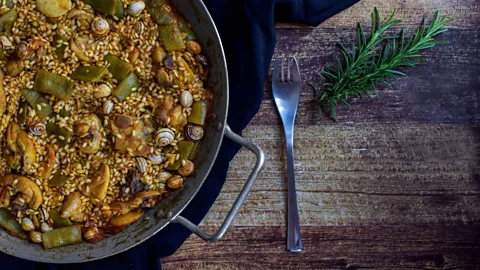 Alamy
Alamy3. Best for a Valencian farmland experience: Napicol
Holding a Michelin Bib Gourmand, Napicol is found on Valencia's city outskirts. "[It's] just 10 minutes from Valencia, right in the middle of La Huerta [the countryside] and it's incredibly beautiful," says Camarena. The drive there allows visitors to see where Valencia's produce is grown, getting a peek at the Valencian Community's rural areas.
Paella etiquette
"To us, eating directly from the paella [pan] is like a religion," says Camarena. "If you’re ever invited to someone's home and you're offered to eat directly from the paella, remember a few unwritten rules. You can only eat from a triangle-shaped section in front of you, from the centre of the paella to your spot at the table, about the size of a pizza slice. Start from the edge and work your way toward the centre. Under no circumstances should you scoop from someone else's section."
Owner and chef Anselmo Rausell sources many of his ingredients from the organic orchard next to the restaurant. While he serves up traditional paella Valenciana, he adds snails to the dish, an ingredient that Camarena considers optional in the original recipe. "Finding snails in your paella is very traditional, but not that common [nowadays]," he says. "A lot of people either don’t like them or feel a bit squeamish about it. However, in a setting like Napicol, I think people are more open to encountering those snails."
"It's challenging to understand how each ingredient contributes flavour to the paella; it's the combination of everything that creates layers of complexity. For me, the snail adds another layer of depth to the flavours in the paella," he adds.
During the summer, Napicol hosts "Summer Nights" on Saturdays, where patrons can enjoy live music on an outdoor stage on the patio while having dinner. "I’d say that enjoying a paella right in the heart of the Valencian countryside at Napicol adds an almost religious significance to the experience," says Camarena.
Website: https://www.napicol.com
Address: Carrer de Sant Isidre, 28, 46133 Alqueria de Roca, Valencia
Phone: +34 961 11 91 10
Instagram: @restaurantenapicol
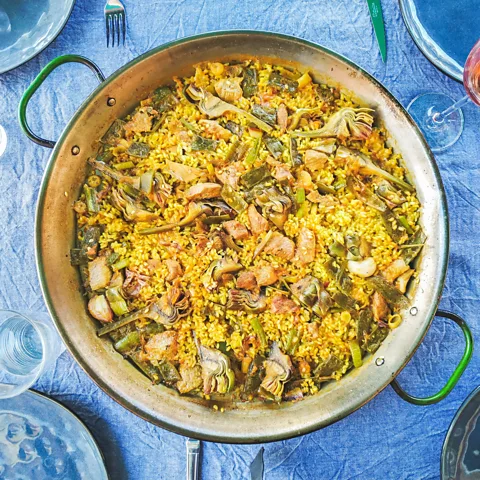 Getty Images
Getty Images4. Best for dining in the city centre: Goya Gallery Restaurant
Goya's first iteration was as a classic Spanish neighbourhood bar when it opened in 1950 in the La Gran Via neighbourhood. Serving typical bar food like bocadillos (sandwiches) and tapas, it attracted big screen names like director Bernardo Bertolucci before eventually closing in 2010. It got a facelift and reopened in 2015 as Goya Gallery, becoming known for its signature rice dishes.
Did you know…
Paella is the name of both the iconic Spanish rice dish and the pan it's cooked in?
"Goya Gallery, located in the centre of Valencia, is another great spot for paella," says Camarena. "Fernando [Navarro] excels at making rice dishes, including paella. His natural talent for cooking is evident in his paella, which is balanced, refined and very well-crafted." When asked what a balanced paella Valenciana looks like, Camarena says, "If a paella doesn't have the right amount of oil, it will be bland and risk burning. If it's too oily, it becomes hard to digest. It's crucial that none of the ingredients overpower the others. If any ingredient stands out, it means the paella isn't balanced. Too much paprika can quickly become overwhelming, as can too much saffron."
Website: https://goyagalleryrestaurant.com
Address: Carrer de Borriana, 3, L'Eixample, 46005 València, Valencia
Phone: +34 963 04 18 35
Instagram: @goyagalleryrestaurant
 Pablo García-Ruiz
Pablo García-Ruiz5. Best for a paella with a perfect, crispy soccarat: Vernetta
Opened in 2019, Vernetta is a relative newcomer to the Valencian arrocerías scene. With a facade resembling a flower shop more than a restaurant, patrons soon learn why Vernetta's tagline is "Mercado de las Flores" (Flower Market).
Despite Vernetta's recent entry into the scene, its chef has a long trajectory of cooking paella. "Vernetta also makes excellent rice dishes," says Camarena. "This guy [Pablo García Vernetta] really nails the paella."
The correct time to eat paella
"For us, paella is undoubtedly a midday dish. It's a meal that requires time to digest; it's quite heavy, which is why it's not typically eaten for dinner," Camarena says, noting that dinner in Spain is usually eaten later than in other countries.
One of the standout features of Vernetta's paella is the perfectly achieved socarrat – paella's crispy bottom layer that's beloved by all Valencians. "Understanding that socarrat is an important part of paella. At Vernetta, they've managed to achieve it nicely – without overusing oil, but with a very even consistency. Socarrat forms when the rice sticks to the bottom of the paella pan, becoming golden and caramelised, creating a crispy layer. This happens because it has the right amount of oil," Camarena explains.
Vernetta's paella Valenciana is fragranced by rosemary, "The final touch of rosemary is quite common, but not everyone knows how to balance it. Here, it's perfectly measured," says Camarena.
Website: https://vernettarestaurante.com
Address: Carrer del Mestre Racional, 15, L'Eixample, 46005 València, Valencia
Phone: +34 961 95 61 79
Instagram: @vernetta_restaurante
BBC Travel's The SpeciaList is a series of guides to popular and emerging destinations around the world, as seen through the eyes of local experts and tastemakers.
--
If you liked this story, sign up for The Essential List newsletter – a handpicked selection of features, videos and can't-miss news, delivered to your inbox twice a week.
